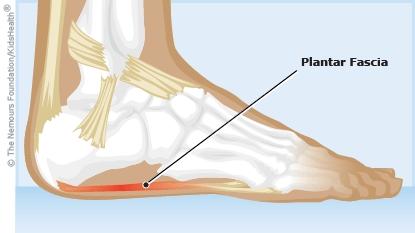The plantar fascia is a thick band of tissue that connects the heel bone to the front of the foot. Plantar fasciitis (PLAN-ter fash-ee-EYE-tus) is when the plantar fascia becomes inflamed (irritated and sore). Kids with plantar fasciitis often have pain on the bottom of the foot, near the heel. Exercises and home treatments can help your child feel better while they heal. Plantar fasciitis usually goes away after a few months, but sometimes it can take longer.


Help your child adjust their activity level:
Follow your health care provider's advice for:
For pain and inflammation, your child can:
Other tips:

Your child:

What causes plantar fasciitis? It's not exactly clear what causes plantar fasciitis. It's more common in adults, but kids can get it too. Kids who get it usually are active in sports like running or dance that stress the heel over and over again. Other things that make it more likely include having flat feet, increasing training too fast, running or walking on hard surfaces (especially without shoes), and carrying extra weight.
What are the symptoms of plantar fasciitis? The pain usually comes on slowly and is near the heel on the bottom of the foot. The pain can sometimes go into the arch of the foot. The pain is often strongest first thing in the morning and usually feels a little better after walking for a few minutes. The pain also can be worse after standing or sitting for a long time, after exercise, or when climbing stairs.
What can help prevent plantar fasciitis? It can help to gently stretch the foot and calf before exercising, increase exercise routines slowly, avoid overtraining, lose any extra weight, and wear supportive shoes that fit well.